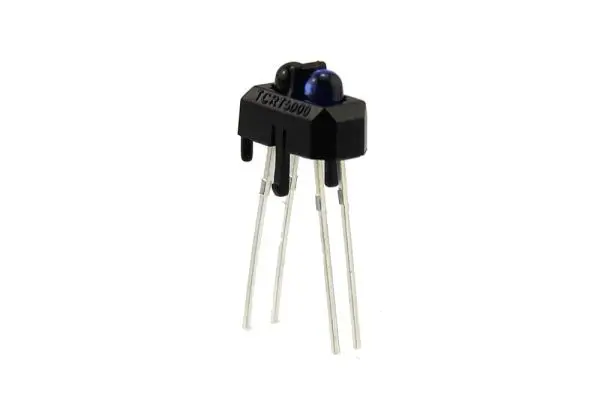Features:
- Compact and space-saving design
- High sensitivity to reflectivity changes
- Wide operating voltage (typically 5V)
- Low power consumption – ideal for battery-powered projects
- Simple analog/digital interface
- Adjustable detection range via external components
- Fast response time for real-time applications
- Cost-effective and reliable for beginner to advanced projects
Description:
The TCRT5000 sensor consists of an IR LED that emits infrared light and a phototransistor that receives the reflected light. When an object passes in front of the sensor, the reflected IR light is captured by the phototransistor, changing the output signal. Its compact design allows it to be used in tight spaces. It supports detection ranges up to 2.5 cm, and it can detect objects with as little as 6% reflectivity. The sensor works well with microcontrollers using either analog or digital inputs.
Principle of Work:
When powered, the IR LED continuously emits light. The amount of light reflected back to the phototransistor depends on the presence and distance of nearby objects. A greater reflection indicates a closer or more reflective object, which changes the output voltage. This can be interpreted by a microcontroller for tasks like line tracking, object counting, or edge detection.
Pinout of the Module:
- Anode (+): Connect to +5V via 100Ω resistor
- Cathode (-): Connect to GND
- Collector: Output signal (connect to analog pin via 4.7kΩ resistor to 5V)
- Emitter: Connect to GND
Note: Anode and Collector legs are the longer ones.
Applications:
- Line-following robots
- Obstacle detection
- Proximity sensing
- Edge detection for surfaces
- Object counters
- Security alarm systems
- Automatic door openers
Circuit:
Basic connection to Arduino:
- Connect Collector to A0 via 4.7kΩ resistor to 5V
- Connect Anode to 5V via 100Ω resistor
- Connect Cathode and Emitter to GND
Library:
No external library required.
Code:
const int sensorPin = A0; // Analog pin for sensor
int sensorValue = 0;
int threshold = 500;
void setup() {
Serial.begin(9600);
}
void loop() {
sensorValue = analogRead(sensorPin);
Serial.print("Analog value: ");
Serial.println(sensorValue);
if(sensorValue < threshold) {
Serial.println("Obstacle detected!");
}
delay(100);
}
Technical Details:
- Operating Voltage: 5V
- Forward Current: 60mA
- Output Type: Analog or Digital
- Collector Current: 100mA max
- Temperature Range: -25°C to +85°C
Resources:
Comparisons:
| Sensor |
Technology |
Range |
Environment |
Cost |
| TCRT5000 |
Infrared |
0–2.5 cm |
Best for reflective surfaces |
Low |
| Ultrasonic |
Sound waves |
Up to several meters |
All surfaces/environments |
Higher |
Features:
- Compact and space-saving design
- High sensitivity to reflectivity changes
- Wide operating voltage (typically 5V)
- Low power consumption – ideal for battery-powered projects
- Simple analog/digital interface
- Adjustable detection range via external components
- Fast response time for real-time applications
- Cost-effective and reliable for beginner to advanced projects
Description:
The TCRT5000 sensor consists of an IR LED that emits infrared light and a phototransistor that receives the reflected light. When an object passes in front of the sensor, the reflected IR light is captured by the phototransistor, changing the output signal. Its compact design allows it to be used in tight spaces. It supports detection ranges up to 2.5 cm, and it can detect objects with as little as 6% reflectivity. The sensor works well with microcontrollers using either analog or digital inputs.
Principle of Work:
When powered, the IR LED continuously emits light. The amount of light reflected back to the phototransistor depends on the presence and distance of nearby objects. A greater reflection indicates a closer or more reflective object, which changes the output voltage. This can be interpreted by a microcontroller for tasks like line tracking, object counting, or edge detection.
Pinout of the Module:
- Anode (+): Connect to +5V via 100Ω resistor
- Cathode (-): Connect to GND
- Collector: Output signal (connect to analog pin via 4.7kΩ resistor to 5V)
- Emitter: Connect to GND
Note: Anode and Collector legs are the longer ones.
Applications:
- Line-following robots
- Obstacle detection
- Proximity sensing
- Edge detection for surfaces
- Object counters
- Security alarm systems
- Automatic door openers
Circuit:
Basic connection to Arduino:
- Connect Collector to A0 via 4.7kΩ resistor to 5V
- Connect Anode to 5V via 100Ω resistor
- Connect Cathode and Emitter to GND
Library:
No external library required.
Code:
const int sensorPin = A0; // Analog pin for sensor
int sensorValue = 0;
int threshold = 500;
void setup() {
Serial.begin(9600);
}
void loop() {
sensorValue = analogRead(sensorPin);
Serial.print("Analog value: ");
Serial.println(sensorValue);
if(sensorValue < threshold) {
Serial.println("Obstacle detected!");
}
delay(100);
}
Technical Details:
- Operating Voltage: 5V
- Forward Current: 60mA
- Output Type: Analog or Digital
- Collector Current: 100mA max
- Temperature Range: -25°C to +85°C
Resources:
Comparisons:
| Sensor |
Technology |
Range |
Environment |
Cost |
| TCRT5000 |
Infrared |
0–2.5 cm |
Best for reflective surfaces |
Low |
| Ultrasonic |
Sound waves |
Up to several meters |
All surfaces/environments |
Higher |
